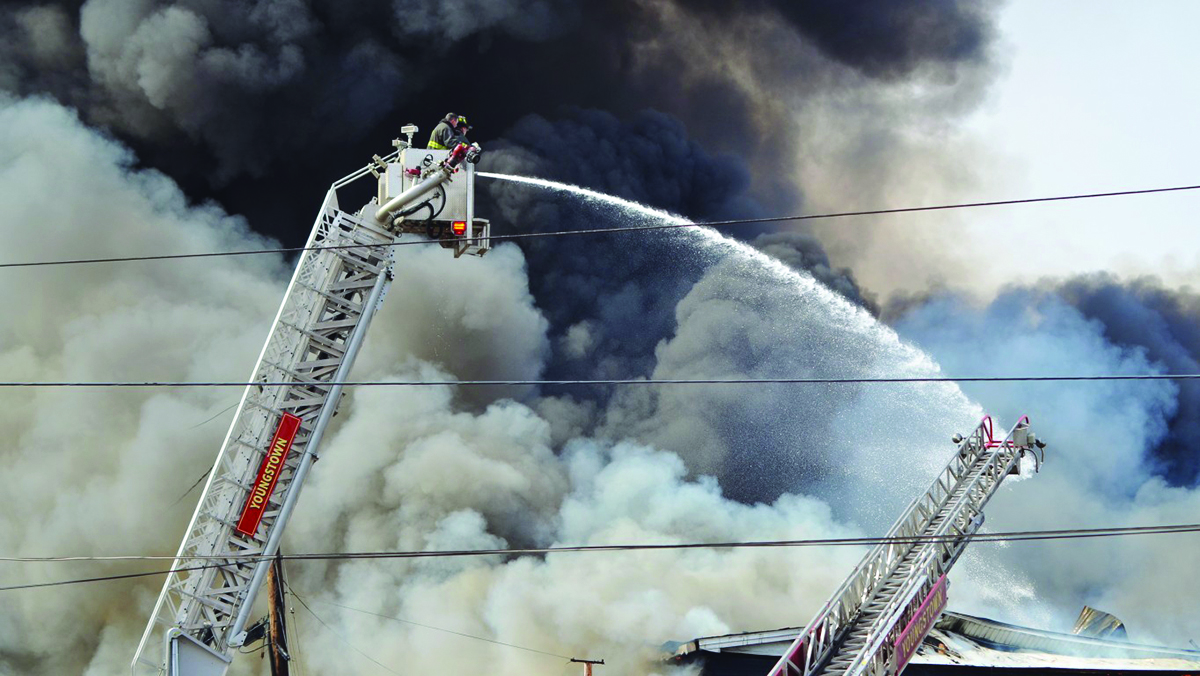By Scott Williams
For students leaving campus on the afternoon of March 19, it would have been rather difficult to miss the dark, black, intense smoke billowing from a Market Street business to the south of the university. Despite recent structure fires within the city of Youngstown, city fire chief John J. O’Neill Jr. reports that the overall number of fires is down.
“I don’t want to get too optimistic,” O’Neill said. “I don’t know at what point you call it a trend. It is really hard to judge that, because I’m sure if you look throughout the years, there maybe have been other dips, but the numbers have, over the last year or so, dipped off a little.”
O’Neill indicated that the number of both car fires and structure fires has decreased.
“With more smart cars on the road today and there being less and less older cars, car fires have started to drop, dipping down to maybe 125 a year. The structure fires over the last two years we have noticed a little dip as well, so instead of 400 a year, we have had like 360. This last year we have dropped more to about 350,” O’Neill said.
While there are, of course, occupied house fires, car fires and business fires — such as the one on March 19 — the vast majority of house fires within the city are of vacant houses, a problem that may be the result of arson.
Susan Clutter, a professor of forensic science, has worked closely with the Youngstown Fire Department and has studied the use of liquid latex to clean the walls of burned homes — a cleaning procedure that removes soot without removing fingerprints and blood spatter that may exist underneath this soot. Clutter said that Youngstown has made an effort to eliminate vacant structures.
“The City of Youngstown has taken some extraordinary effort to get rid of as many vacant homes as they can,” Clutter said. “They’ve also tried to demolish a number of factories in the area.”
As the city demolishes vacant structures, Clutter said the number of arsons might begin to decrease. Despite the city’s recent efforts to demolish vacancies, Clutter said that arson rates in this area have thus far remained steady from one year to the next.
“Arson is a crime of opportunity, but it is also a crime that is very difficult because a lot of the people who are committing the arsons in this region are thinking that they’re being good Samaritans by burning vacant homes,” Clutter said.
While Clutter explained that arson rates remain generally consistent in recent years, O’Neill indicated that there has been a slight decrease in the number of arsons. He acknowledged, however, that this may be the result of a harsh winter.
“Here is why you have to watch when you have a little dip: the past two years we have had really bad winters. I just know from being from around here, when you have a bad winter with a lot of snow, the vacant house fires drop because the arsons may not want to go out in the cold or they don’t want their foot prints in the snow,” O’Neill said. “It could be any of those reasons, but when the winter is bad, the numbers do drop. If it is a mild winter, they’re not going to drop.”
During this past winter, while there have been a decrease in the amount of vacant house fires, the chief has noticed an increase in occupied house fires, citing an aging housing stock as a contributing factor.
“Our vacant house problem is just one issue. We also have an aging housing stock, and there is good proof of that in the winter months. When the winter is very cold and you have people using space heaters, candles, fire places — all of that typical stuff — and you have an aging housing stock, in occupied homes this year I have noticed a little bit of an uptick in occupied house fires this winter,” O’Neill said.
O’Neill explained that people use fireplaces when it is really cold — these fireplaces probably shouldn’t be used. With a house that is over 70 years old, the conditions of its fireplace and chimney may go unchecked, leading to house fires.
While overall numbers are down, the Youngstown Fire Department has not seen much change in operations. The department is made up of eight stations, ten total fire trucks and an average on-duty staff of about 32 people. O’Neill said that it is impossible for him to schedule for worst-case scenarios; he instead has to schedule for what he will likely face.
“This past week, we had two two-alarm fires and a fatal fire. All three of those fires in a week required every person that we had on staff at one time or another to be there. We also had to pull in backup crews so we could protect the rest of the city,” O’Neill said.
Those are the extreme days; an average fire requires attention from only about half of the on duty staff.
“Our frequency of having two structure fires at the same time is actually high in the city. We can go out two or three times a month where we have two fires going simultaneously. When that happens, I have nothing left. We are stripped out,” O’Neill said.
With another rigorous list of vacant demolitions to happen in the coming summer months, the chief is cautiously optimistic that the amount of fires will remain down.
Additional reporting by Frank George.
